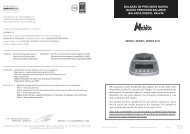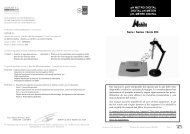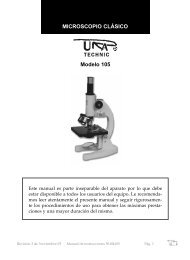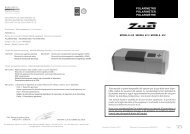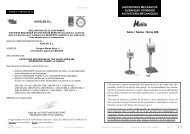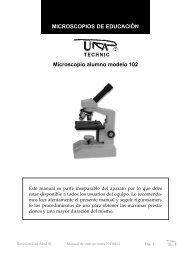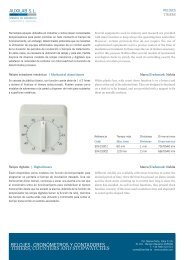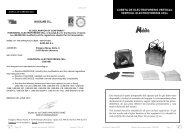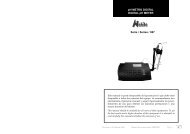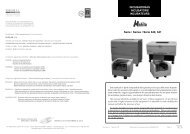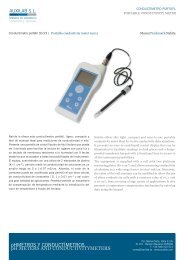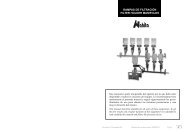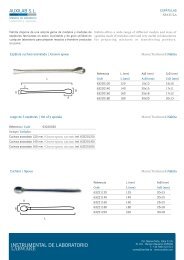MICRÃTOMO DE ROTACIÃN ROTATION MICROTOME ... - Auxilab
MICRÃTOMO DE ROTACIÃN ROTATION MICROTOME ... - Auxilab
MICRÃTOMO DE ROTACIÃN ROTATION MICROTOME ... - Auxilab
Create successful ePaper yourself
Turn your PDF publications into a flip-book with our unique Google optimized e-Paper software.
MICRÓTOMO <strong>DE</strong> ROTACIÓN<br />
<strong>ROTATION</strong> <strong>MICROTOME</strong><br />
Serie / Series / 591<br />
Este manual es parte inseparable del aparato por lo que debe estar<br />
disponible a todos los usuarios del equipo. Le recomendamos leer<br />
atentamente el presente manual y seguir rigurosamente los procedimientos<br />
de uso para obtener las máximas prestaciones y una<br />
mayor duración del mismo.<br />
This manual should be available for all users of these equipments. To get<br />
the best results and a higher duration of this equipment it is advisable to<br />
read carefully this manual and follow the processes of use.<br />
Revisión 1 June-2007 Manual de instrucciones 52507000 Pág. 1
CASTELLANO<br />
Gracias por haber adquirido este equipo. Deseamos sinceramente que disfrute del<br />
microtomo de rotación Nahita 591 Le recomendamos que cuide el equipo conforme a lo<br />
expuesto en este manual.<br />
Nahita desarrolla sus productos según las directrices del marcado CE y haciendo hincapié<br />
en la ergonomía y seguridad del usuario.<br />
La calidad de los materiales empleados en la fabricación y el correcto proceder le permitirán<br />
disfrutar del equipo por muchos años.<br />
El uso incorrecto o indebido del equipo puede dar lugar a accidentes, descargas eléctricas,<br />
cortocircuitos, fuegos, lesiones, etc. Lea el punto de Mantenimiento, donde se recogen<br />
aspectos de seguridad.<br />
LEA <strong>DE</strong>TALLADAMENTE ESTE MANUAL <strong>DE</strong> INSTRUCCIONES ANTES <strong>DE</strong><br />
OPERAR CON ESTE EQUIPO CON EL FIN <strong>DE</strong> OBTENER LAS MÁXIMAS PRES-<br />
TACIONES Y UNA MAYOR DURACIÓN <strong>DE</strong>L MISMO.<br />
ANEXO I: CERTIFICADO CE<br />
AUXILAB S.L.<br />
<strong>DE</strong>CLARATION OF CONFORMITY<br />
NAHITA <strong>MICROTOME</strong> of <strong>Auxilab</strong>, S.L for the Directive<br />
of Machines (89/392/CEE modified) and the regulations<br />
adopted for their transposition<br />
NAME OF THE MANUFACTURER / IMPORTER:<br />
AUXILAB, S.L.<br />
ENGLISH<br />
Tenga especialmente presente lo siguiente:<br />
• Este manual es parte inseparable del microtomo de rotación Nahita 591, por lo que debe<br />
estar disponible para todos los usuarios del equipo.<br />
• Debe manipularse siempre con cuidado evitando los movimientos bruscos, golpes, caídas<br />
de objetos pesados o punzantes; evite el derrame de líquidos en su interior.<br />
• Nunca desmonte el equipo para repararlo usted mismo, además de perder la garantía<br />
podría producir un funcionamiento deficiente de todo el equipo, así como daños a las personas<br />
que lo manipulan.<br />
• Cualquier duda puede ser aclarada por su distribuidor (instalación, puesta en marcha,<br />
funcionamiento). Usted puede también mandarnos sus dudas o sugerencias a la siguiente<br />
dirección de correo del Servicio Técnico Nahita (asistencia@auxilab.es) o bien llamando<br />
al Tfno.: 807117040 (0.30 Euros/min).<br />
• Este equipo está amparado por la Ley de garantías y bienes de consumo (10/2003).<br />
• No se consideran en garantía las revisiones del equipo.<br />
• La manipulación del equipo por personal no autorizado provocará la pérdida total de<br />
la garantía.<br />
• Los accesorios, así como la pérdida de los mismos, no están cubiertos por dicha garantía.<br />
Tampoco estarán cubiertos por el periodo de garantía las piezas en su desgaste por uso<br />
natural.<br />
• Asegúrese de guardar la factura de compra para tener derecho de reclamación o prestación<br />
de la garantía. En caso de enviar el equipo al Servicio Técnico adjunte factura o<br />
copia de la misma como documento de garantía.<br />
• Rellene y envíe la garantía antes de los 15 días después de la compra.<br />
• El fabricante se reserva los derechos a posibles modificaciones y mejoras sobre este<br />
manual y equipo.<br />
¡ATENCIÓN! NO SE ADMITIRÁ NINGÚN APARATO PARA REPARAR<br />
QUE NO ESTÉ <strong>DE</strong>BIDAMENTE LIMPIO Y <strong>DE</strong>SINFECTADO.<br />
Pág. 2 Manual de instrucciones 50591000 Revisión 1 Febrero-07<br />
ADDRESS: Polígono Morea Norte, 8<br />
31191 Beriáin (Navarra)<br />
WE STATE THAT:<br />
Is designed and manufactured according to:<br />
<strong>MICROTOME</strong> 591<br />
CO<strong>DE</strong> 50591000<br />
• Directive 89/392/CEE, including the modifications and national regulations that<br />
transpose them.<br />
• And that the following harmonized rules have been applied (or a part of them):<br />
UNE 61010-1/A2, UNE-EN61010-2-051.<br />
BERIAIN 28th February 2007<br />
Signed by: ALFONSO AINCIBURU SANZ<br />
DIRECTOR/MANAGER<br />
Polígono Morea Norte, 8 31191 Beriain (Navarra) - Spain. Tel. 948 310 513 Fax 948 312 071<br />
Internet: www.auxilab.es · Email: correo@auxilab.es<br />
Version 1 February-07 Instruction manual 50591000 Page 23
TROUBLE CAUSE SOLUCIÓN<br />
Knife clearance angle too<br />
wide.<br />
ENGLISH<br />
Systematically reduce clearance<br />
angle until optimum<br />
angle width has been found.<br />
ÍNDICE <strong>DE</strong> IDIOMAS<br />
Castellano<br />
Inglés<br />
CASTELLANO<br />
3-12<br />
13-23<br />
No blade feed, no more<br />
sections<br />
Blades wear out very<br />
quickly<br />
Insufficient clamping of<br />
sample and/or knife holder<br />
Blade has reached front<br />
limit stop position.<br />
Cutting forces too high<br />
Check all screws and<br />
clamping mechanisms at<br />
sample holder system and<br />
knife holder. Retighten if<br />
necessary.<br />
Move blade backwards<br />
via coarse feed knob.<br />
Select sectioning speed or<br />
section thickness. Reduce<br />
section thickness or turn<br />
handwheel at slower speed.<br />
ÍNDICE <strong>DE</strong> CONTENIDOS<br />
1. APLICACIONES <strong>DE</strong>L INSTRUMENTO<br />
2. <strong>DE</strong>SCRIPCIÓN<br />
3. ESPECIFICACIONES TÉCNICAS<br />
4. PUESTA EN SERVICIO<br />
5. MODO <strong>DE</strong> USO<br />
6. MANTENIMIENTO Y LIMPIEZA<br />
7. PROBLEMAS MÁS COMUNES<br />
ANEXO I: CERTIFICADO CE<br />
1. APLICACIONES <strong>DE</strong>L INSTRUMENTO<br />
3<br />
3<br />
6<br />
6<br />
6<br />
9<br />
10<br />
12<br />
El microtomo de rotación Nahita 591 está diseñado con la tecnología más avanzada para<br />
la realización de cortes de tejidos vegetales o animales incluidos en parafina en las aplicaciones<br />
histológicas de rutina en centros médicos y de investigación.<br />
2. <strong>DE</strong>SCRIPCIÓN<br />
INSTRUCTIONS ON ENVIRONMENT PROTECTION<br />
At the end of its life cycle, please, do not dispose of this equipment<br />
by throwing it in the usual garbage; hand it over a collection point for<br />
the recycling of electrical and electronic appliances. It does not contain<br />
dangerous or toxic products for humans but a non adequate disposal<br />
would damage the environment.<br />
The materials are recyclable as mentioned in its marking. By recycling material or by<br />
other forms of re-utilization of old appliances, you are making an important contribution<br />
to protect our environment.<br />
Please inquire at the community administration for the authorized disposal location.<br />
El microtomo es un equipo mecánico de precisión que se utiliza para realizar cortes en<br />
tejidos que han sido objeto de inclusión en parafina, siendo las secciones conseguidas de<br />
espesor micrométrico lo suficientemente delgadas para permitir su examen por el microscopio.<br />
Existen diversos tipos de microtomos (de mano, de balanceo, de rotación, de deslizamiento,<br />
criostato, ultramicrotomo, etc.) siendo el más empleado el de rotación por las ventajas<br />
que aporta: gran precisión y la posibilidad de producir secciones en serie muy finas,<br />
gracias a la desmultiplicación que produce el cambio de un movimiento de rotación a otro<br />
de traslación.<br />
El microtomo de rotación consta de las siguientes partes:<br />
Porta-muestras: es el dispositivo en el que se<br />
coloca el tejido incluido en algún medio de<br />
homogeneización, generalmente parafina.<br />
Gracias a los tornillos podemos orientar la superficie<br />
del bloque de parafina de manera que quede<br />
perfectamente paralelo a la cuchilla.<br />
Page 3 Instruction manual 50591000 Version 1 February-07<br />
Revisión 1, Febrero-07 Manual de instrucciones 50591000 Pág. 3
Porta-cuchillas: mediante un mando de avance<br />
macro se puede regular el grado de aproximación<br />
de la cuchilla al porta-muestras.<br />
Mecanismo de avance: en los microtomos de rotación es el portabloques el que<br />
avanza sobre la cuchilla a la vez que realiza un movimiento arriba-abajo, permaneciendo<br />
la cuchilla inmóvil en todo momento. Para realizar esta serie de movimientos<br />
es necesario un complejo sistema mecánico que permite la realización de<br />
cortes sucesivos de tejidos a partir del bloque.<br />
Cuchilla: desechable universal.<br />
CASTELLANO<br />
Cleaning<br />
ENGLISH<br />
• Never use scourers or substances that can grate for cleaning metallic parts such as stainless<br />
steel, aluminium, coatings, etc. as they damage the microtome and produce an early<br />
ageing of the equipment. Neither use alcohol or alcohol containing detergents nor abrasive<br />
detergents or acetone or xylene containing solvents.<br />
• Use a fluff-free cloth dampened with soaped water that does not contain abrasives.<br />
ATTENTION!! IF EQUIPMENTS ARE NOT PROPERLY CLEAN AND<br />
DISINFECTED THEY WOULD NOT BE ALLOWED TO REPAIR BY OUR<br />
TECHNICAL SERVICE.<br />
7. TROUBLESHOOTING<br />
TROUBLE<br />
CAUSE<br />
SOLUTIÓN<br />
Volante manual: Transmite al mecanismo de<br />
avance el impulso necesario para su funcionamiento;<br />
cada vuelta dada al volante produce una<br />
secuencia de corte. El volante manual presenta<br />
un pequeño mecanismo que lo bloquea en caso<br />
de que el equipo deba ser transportado o cuando<br />
no está siendo utilizado. Por tanto, antes de usar<br />
el microtomo es imprescindible tirar del mecanismo<br />
de bloqueo y dar medio giro al volante<br />
manual para colocarlo en posición de corte.<br />
1. Base porta-cuchillas<br />
2. Palanca sujeción del mecanismo de<br />
desplazamiento lateral<br />
3. Palanca sujeción del porta-cuchillas<br />
4. Porta-cuchillas<br />
5. Palanca sujeción cuchilla<br />
6. Escala ángulo libre<br />
7. Mando selección del espesor de corte<br />
8. Avance macro<br />
9. Palanca bloqueo avance macro<br />
10. Volante manual<br />
11. Bloqueo volante<br />
12. Dispositivo de sujeción del portamuestras<br />
13. Palanca sujeción del porta-muestras<br />
14. Pinza universal para casetes<br />
15. Expulsor de casetes<br />
16. Tornillo de orientación Norte/Sur del<br />
porta-muestras<br />
17. Tornillo de orientación Este/oeste del<br />
porta-muestras<br />
18. Palanca bloqueo orientación<br />
Alternately thick and<br />
thin sections are produced<br />
In extreme cases, no<br />
section is obtained.<br />
Sections are extremely<br />
compressed, wrinkled or<br />
jammed together<br />
Noise during sectioning<br />
Knife "sing." when sectioning<br />
hard samples.<br />
Sections show scratches.<br />
Blade insufficiently clamped<br />
Blunt cutting edge<br />
Knife clearance angle too<br />
narrow.<br />
Blunt cutting edge<br />
Sample too warm<br />
Sectioning speed too high<br />
Sectioning speed too high<br />
Re-clamp blade<br />
Adjust knife holder laterally<br />
or use new blade.<br />
Systematically try wider<br />
clearance angle until optimum<br />
angle width has been<br />
found.<br />
Use different zone of cutting<br />
blade or use new blade.<br />
Cool sample prior to sectioning<br />
Work at lower sectioning<br />
speed<br />
Work at lower sectioning<br />
speed<br />
Pág. 4 Manual de instrucciones 50591000 Revisión 1 Febrero-07<br />
Version 1 February-07 Instruction manual 50591000 Page 4
ENGLISH<br />
• Put the microtome on top of a horizontal, plane and stable table making a free space at<br />
least at 30 cm per side.<br />
• Do not expose the microtome directly to the sun, etc. Avoid vibrations, dust and dry<br />
environments.<br />
• Always remove the blade before detaching the knife holder from the instrument.<br />
• Never try to catch a falling knife.<br />
• Never place a knife anywhere with the cutting edge facing upwards.<br />
• Always clamp the sample block before clamping the knife.<br />
• When working with cleaning detergents, please bear in mind manufacturer safety instructions<br />
as well as current laboratory regulations.<br />
• Wear glasses in case of working with samples that can produce splinters.<br />
• Always lock the handwheel prior to equipment cleaning (see Cleaning), prior to any<br />
manipulation of knife or sample and during all work breaks.<br />
• No fluid must enter the interior of the equipment during cleaning.<br />
• Never try to repair the microtome by yourself, since you will lose the warranty and may<br />
provoke damages to the general operating system.<br />
• Made under the European regulations for security on machines.<br />
13<br />
11<br />
10<br />
CASTELLANO<br />
15<br />
16<br />
6. MAINTENANCE AND CLEANING<br />
To get the best results and a higher duration of the microtome it is essential to follow<br />
the processes of use.<br />
17<br />
Note: All the processes of use mentioned below will not have any value unless you keep<br />
a continued and careful maintenance.<br />
• Please follow the processes of use of this manual.<br />
• This manual should be available for all users of this equipment.<br />
• Always use original components and supplies. Other devices can be similar but they<br />
can damage the equipment.<br />
• Never try to repair the microtome by yourself, since you will lose the warranty and may<br />
provoke damages to the general operating system.<br />
• In the event of breakdown please contact your distributor to overhaul through Nahita<br />
Technical Assistance Department.<br />
2<br />
4 5<br />
14<br />
9<br />
6<br />
3<br />
12<br />
18<br />
Before each cleaning:<br />
• Move sample clamp to uppermost position and lock handwheel.<br />
• Insert the knife into the receptacle for used blades in the base of the blade dispenser.<br />
• Remove knife holder and knife holder base for cleaning.<br />
• Remove sample from sample clamp.<br />
• Remove section waste with a dry brush.<br />
• Remove sample clamp and clean it.<br />
7<br />
8<br />
1<br />
Page 20 Instruction manual 50591000 Version 1 February-07<br />
Revisión 1, Febrero-07 Manual de instrucciones 50591000 Pág. 5
3. ESPECIFICACIONES TÉCNICAS<br />
Espesor del corte 1-25 μ m<br />
Regulación mínima 1 μm<br />
Ángulo libre 0-10º<br />
Avance macro<br />
Manual, a través de mando de avance macro<br />
Espesor de desbaste Seleccionable máx. 25 μ m<br />
Dimensiones (LxWxH)<br />
Peso<br />
4. PUESTA EN SERVICIO<br />
5. MODO <strong>DE</strong> USO<br />
5.1 Colocación de la muestra<br />
320x380x320 mm<br />
42 Kg (aprox.)<br />
CASTELLANO<br />
Desembale el microtomo y retire todas las protecciones que lo envuelven. Asegúrese de<br />
que no presenta ningún daño debido al transporte. De ser así, comuníquelo inmediatamente<br />
a su transportista o suministrador para que pueda hacer las debidas reclamaciones<br />
en el plazo establecido.<br />
Guarde el embalaje, ya que siempre se deben realizar las devoluciones en su embalaje<br />
original con todos los accesorios suministrados.<br />
Solo aceptamos devoluciones de equipos en los 15 días posteriores al envío y siempre<br />
que vengan completos en su embalaje original.<br />
4.1 Montaje de la pinza universal para casetes<br />
El dispositivo de sujeción del porta-muestras le permitirá ajustar la pinza porta-casetes:<br />
• Coloque el dispositivo de sujeción para las pinzas porta-casetes (1.12) en el punto más<br />
alto; para ello gire el volante manual (1.10) y bloquéelo mediante el dispositivo de seguridad<br />
situado en su parte inferior (1.11).<br />
• Para colocar la pinza porta-casetes gire la palanca de sujeción del porta-muestras (1.13)<br />
en sentido contrario de las agujas del reloj.<br />
• Inserte la pinza porta-casetes (1.14) desde la derecha y deslícela hasta llegar al tope.<br />
• Para fijar la pinza porta-casetes, gire la palanca de sujeción del porta-muestras (1.13) en<br />
sentido de las agujas de reloj.<br />
4.2 Colocación del porta-cuchillas<br />
• Afloje la palanca de sujeción del porta-cuchillas (1.3) girándola en sentido contrario de<br />
las agujas del reloj.<br />
• Deslice la ranura del porta-cuchillas (1.4) sobre la pieza en T de la base del porta-cuchillas.<br />
• Sujete el porta-cuchillas girando la palanca de sujeción (1.3) en sentido de las agujas del<br />
reloj.<br />
ENGLISH<br />
• Orientate sample in north-south direction with screw (1.16) and in east-west direction<br />
with screw (1.17).<br />
• Turn clamp upwards.<br />
5.5 Trimming the sample<br />
Sample can be trimmed via the section thickness selection (max. 25 μ m):<br />
• Approach the knife holder to the sample via the coarse feed knob (1.8).<br />
• Select section thickness (e.g. 25 μ m) with the adjusting knob (1.7).<br />
• Turn handwheel (1.10) until sample has been trimmed down to the desired level.<br />
5.6 Sectioning<br />
NOTE: always rotate handwheel evenly. Rotating speed must be adjusted to the sample<br />
hardness; harder samples should be cut at slower speed.<br />
Never cut sample with the same region of the blade edge used for trimming. The knife<br />
holder base presents a lateral displacement system that allows the use of the entire width<br />
of the blade without having to release the knife:<br />
• Turn backwards the clamp located at the left side of the knife holder base (1.2) to relea-<br />
• se.<br />
•<br />
Move laterally the knife holder base with the knife holder to the desired position.<br />
Hold the knife holder base at this position by turning forwards the lever (1.2).<br />
Before sectioning it is essential to unlock the manual handwheel; for this purpose pull<br />
the locking device and give a half-turn to the handwheel to place it on cutting position.<br />
•<br />
•<br />
Select the section thickness (in microns) through the corresponding knob (1.7)<br />
For sectioning, turn handwheel evenly (1.10) in clockwise direction.<br />
IMPORTANT: Do not lock the coarse feed knob while rotating the manual handwheel.<br />
If the coarse feed knob is locked the knife does not advance and sectioning is not possible.<br />
•<br />
Pick up the obtained sections and mount them on microscope slides.<br />
• 5.7 Finishing operation<br />
• Move sample clamp to uppermost position and lock the handwheel.<br />
• Insert the knife into the receptacle for used blades in the base of the blade dispenser.<br />
• Remove sample from sample clamp.<br />
• Remove all section waste.<br />
Clean the equipment (see Cleaning).<br />
• 5.8 Security<br />
The microtome must be used by previously qualified staff that knows how the equip-<br />
Pág. 6 Manual de instrucciones 50591000 Revisión 1 Febrero-07<br />
Version 1 February-07 Instruction manual 50591000 Page 19
ENGLISH<br />
wheel must be always locked before changing the sample as well as during all work<br />
breaks.<br />
• Move the holding device for sample clamp (1.12) to the uppermost position; for this<br />
purpose, turn the manual handwheel (1.10) and lock it by the device located at the lower<br />
side (1.11).<br />
• Insert the cassette horizontally or vertically into the sample clamp. For this purpose,<br />
pull forward the expelling lever (1.15) and place the cassette. Release the lever to secure<br />
the cassette in position.<br />
5.2 Placing the knife<br />
Nahita microtome 591 is equipped with a knife holder for standard disposable blades<br />
of common use.<br />
NOTE: Be careful when handling disposable blades for microtome. The blade edge is<br />
extremely sharp and can cause severe injuries<br />
• Turn upwards the knife holding clamp (1.5).<br />
• Carefully insert the disposable blade from one side into the knife holder.<br />
• To hold the knife, turn downwards the holding clamp (1.5).<br />
• Pay attention to the blade edge; replace the knife when the obtained sections present<br />
scratches that could make them useless.<br />
5.3 Adjusting the clearance angle<br />
The marks (0º, 5º and 10º) for clearance angle adjustment (1.6) are on the right side of<br />
the knife holder. Another mark is on the right side of the knife holder base which serves<br />
as a reference point to select the desire angle.<br />
• Rotate anticlockwise the clamping lever for knife holder (1.3) to release.<br />
• Adjust the knife holder position until the selected mark matches the reference mark on<br />
the knife holder base.<br />
• Hold the knife holder at this position and turn clockwise the camping lever (1.3) to secure<br />
it.<br />
5.4 Sample orientation<br />
Orientation system of the sample holder allows adjusting the position of the block surface<br />
without having to release the clamping lever.<br />
• Unlock the coarse feed knob (1.8) by turning to the right the locking lever (1.9).<br />
• Rotate the coarse feed knob and make advance the knife holder base with the knife holder<br />
until nearly reaching the sample.<br />
• Move the holding device for sample clamp (1.12) to the uppermost position and lock the<br />
manual handwheel.<br />
• Release the locking lever of the orientation system (1.18) by turning downwards.<br />
CASTELLANO<br />
NOTA: siempre monte primero la muestra y después la cuchilla.<br />
Siempre se debe bloquear el volante manual antes de cambiar las muestras así como<br />
durante las pausas de trabajo.<br />
• Coloque el dispositivo de sujeción para las pinzas porta-casetes (1.12) en el punto más<br />
alto; para ello gire el volante manual (1.10) y bloquéelo mediante el dispositivo de seguridad<br />
situado en su parte inferior (1.11).<br />
• Inserte el casete en posición horizontal o vertical en la pinza porta-muestras. Para ello,<br />
tire hacia delante de la palanca expulsor de casetes (1.15) y coloque el casete. Suelte la<br />
palanca para que el casete quede sujeto.<br />
5.2 Colocación de la cuchilla<br />
El microtomo Nahita 591 está equipado con un porta-cuchillas para cuchillas desechables<br />
de uso corriente.<br />
NOTA: Cuidado al manejar cuchillas desechables de microtomo. El filo es muy agudo,<br />
podría cortarse fácilmente.<br />
• Gire hacia arriba la palanca de sujeción de la cuchilla (1.5).<br />
• Inserte la cuchilla desechable cuidadosamente desde un lado en el porta-cuchillas.<br />
• Para sujetar la cuchilla gire hacia abajo la palanca de sujeción (1.5).<br />
• Preste atención al filo de la cuchilla; sustituya la cuchilla cuando vea que se producen<br />
rayas en los cortes obtenidos que pueden llegar a fragmentar todo el corte y hacer que<br />
deban ser desechados.<br />
5.3 Ajuste del ángulo libre<br />
Las marcas (0º, 5º y 10º) para el ajuste del ángulo libre (1.6) se encuentran en el lado<br />
derecho del porta-cuchillas. En el lado derecho de la base porta-cuchillas se encuentra otra<br />
raya índice que sirve como punto de referencia para seleccionar el ángulo.<br />
• Afloje la palanca de sujeción del porta-cuchillas (1.3) girándola en sentido de las agujas<br />
del reloj.<br />
• Ajuste el porta-cuchillas, orientándose hasta que la raya deseada coincida con la raya de<br />
referencia en la base porta-cuchillas.<br />
• Mantenga el porta-cuchillas en la posición seleccionada y sujetándolo gire la palanca<br />
(1.3) en sentido de las agujas del reloj.<br />
5.4 Orientación de la muestra<br />
• El sistema de orientación del porta-muestras permite ajustar la posición de la superficie<br />
de la muestra sin tener que aflojar la palanca de sujeción.<br />
• Desbloquee el mando de avance macro (1.8) girando la palanca de bloqueo (1.9) hacia<br />
la derecha<br />
• Gire el mando de avance macro y haga avanzar la base porta-cuchillas junto con el<br />
porta-cuchillas hasta que se encuentre justamente delante de la muestra.<br />
• Coloque el dispositivo de sujeción para las pinzas porta-casetes (1.12) en el punto más<br />
alto y bloquee el volante manual.<br />
Page 18 Instruction manual 50591000 Version 1 February-07<br />
Revisión 1, Febrero-07 Manual de instrucciones 50591000 Pág. 7
CASTELLANO<br />
5.5 Desbaste de la muestra<br />
La muestra puede ser desbastada mediante la selección de un espesor de corte grueso<br />
(máx. 25 μ m):<br />
• Mediante el mando de avance macro (1.8) acerque el porta-cuchillas a la muestra.<br />
• Con el mando de selección (1.7), seleccione un espesor de corte grueso (ej. 25 μm).<br />
• Desbaste la muestra girando el volante manual (1.10) hasta llegar al plano de corte deseado.<br />
5.6 El corte<br />
NOTA: siempre gire el volante manual uniformemente. La velocidad de giro tiene que<br />
ajustarse a la dureza de la muestra; cuanto más dura es la muestra, más lenta es la velocidad<br />
de giro.<br />
Para cortar no trabaje con la misma zona del filo de la cuchilla que ha sido utilizada para<br />
el desbaste. La base porta-cuchillas dispone de un sistema de desplazamiento lateral que<br />
permite aprovechar toda la longitud del filo sin necesidad de aflojar el sistema de sujeción<br />
de la cuchilla:<br />
• Afloje la palanca situada en la parte izquierda de la base porta-cuchillas (1.2), girándola<br />
hacia atrás.<br />
• Desplace lateralmente la base porta-cuchillas junto con el porta-cuchillas hasta encontrar<br />
una zona del filo aún no desgastada por el desbaste.<br />
• Sujete la base porta-cuchillas en esta posición girando la palanca (1.2) hacia delante.<br />
• Antes de realizar los cortes es imprescindible liberar el volante manual, para lo que se<br />
debe tirar del mecanismo de bloqueo e imprimir un giro de media vuelta al volante para<br />
colocarlo en posición de corte.<br />
• Seleccione el espesor de corte deseado (en micras) mediante el mando correspondiente<br />
(1.7)<br />
• Para cortar, gire el volante manual (1.10) uniformemente en sentido de las agujas del<br />
reloj.<br />
IMPORTANTE: No bloquee el mando de avance macro mientras se este girando el<br />
volante manual. Con el mando de avance macro bloqueado la cuchilla no avanza y no se<br />
pueden realizar cortes.<br />
• Recoja los cortes obtenidos y móntelos sobre portaobjetos.<br />
5.7 Fin del trabajo<br />
• Desplace la pinza porta-muestras con el volante manual al punto más alto y bloquee el<br />
volante.<br />
• Inserte la cuchilla en la parte inferior del dispensador de cuchillas.<br />
• Saque la muestra de la pinza porta-casetes.<br />
• Elimine todos los desechos.<br />
• Limpie el equipo (ver apartado limpieza).<br />
Pág. 8 Manual de instrucciones 50591000 Revisión 1 Febrero-07<br />
3. TECHNICAL SPECIFICATIONS<br />
Slice thickness 1-25 μ m<br />
Min. adjustment 1 μ m<br />
Clearance angle 0-10º<br />
Coarse feed<br />
Manual, through coarse feed knob<br />
Trimming thickness Adjustable max. 25 μm<br />
Dimensions (LxWxH)<br />
320x380x320 mm<br />
Weight<br />
42 Kg (approx.)<br />
4. SETTING-UP<br />
Unwrap the microtome and take off all the protections in which it comes fitted. Make<br />
sure that the equipment does not present any damage because of the shipment. In case it<br />
presents any damage, tell it immediately to your transport agent or dealer so that they can<br />
make the claims in the correct time limit.<br />
Please keep the original wrapping; you will always need it for returns enclosed with all<br />
the accessories supplied.<br />
We will only accept any equipment return within 15 days after delivery and provided<br />
it comes in its original wrapping.<br />
4.1 Mounting the universal cassette clamp<br />
The holding device of the sample holder will let you adjust the cassette clamp:<br />
• Move the holding device for sample clamp (1.12) to the uppermost position; for this<br />
purpose, turn the manual handwheel (1.10) and lock it by the device located at the lower<br />
side (1.11).<br />
• For placing the cassette clamp turn anticlockwise the clamping lever for sample clamp<br />
(1.13).<br />
• Insert the cassette clamp (1.14) from the right side and slide it.<br />
• To secure the cassette clamp, turn clockwise the clamping lever (1.13).<br />
4.2 Mounting the knife holder<br />
• Turn anticlockwise the camping lever for knife holder (1.3) to release it.<br />
• Slide the groove of knife holder (1.4) onto T-piece of knife holder base.<br />
• Hold the knife holder by turning clockwise the corresponding camping lever (1.3).<br />
5. OPERATION<br />
5.1 Placing the sample<br />
NOTE: Always clamp the sample block before clamping the knife. The manual hand<br />
Version 1 February-07 Instruction manual 50591000 Page 17<br />
ENGLISH
17<br />
13<br />
11<br />
10<br />
15<br />
ENGLISH<br />
16<br />
CASTELLANO<br />
5.8 Seguridad<br />
• El microtomo debe ser utilizado por personal cualificado previamente, que conozca el<br />
equipo y su manejo mediante el manual de uso.<br />
• Coloque el microtomo sobre una mesa horizontal, plana y estable, creando un espacio<br />
libre de al menos 30 cm por cada lado.<br />
• No coloque el microtomo junto a equipos que produzcan vibraciones ni en zonas próximas<br />
a fuentes de calor (mecheros, sopletes...). No exponga el equipo directamente a la<br />
luz del sol.<br />
• Antes de desmontar el porta-cuchillas siempre debe retirarse la cuchilla desechable.<br />
• Nunca intente coger una cuchilla que se esté cayendo.<br />
• Nunca coloque las cuchillas en algún lugar con el filo señalando hacia arriba.<br />
• Siempre monte primero la muestra y después la cuchilla.<br />
• Al trabajar con detergentes de limpieza, tenga en cuenta las instrucciones de seguridad<br />
del fabricante así como los reglamentos de laboratorio vigentes.<br />
• Lleve gafas de protección en caso de cortar muestras con peligro de producir astillas.<br />
• Bloquee siempre el volante manual antes de limpiar el equipo (ver apartado de limpieza),<br />
antes de manipular las muestras y/o cuchillas así como durante las pausas de trabajo.<br />
• No debe entrar líquido en el interior del equipo durante la limpieza.<br />
• No intente repararlo usted mismo; además de perder la garantía puede causar daños en<br />
el funcionamiento general del equipo.<br />
• Fabricado según las directivas europeas de seguridad en máquinas.<br />
14<br />
6. MANTENIMIENTO Y LIMPIEZA<br />
2<br />
4 5<br />
6<br />
18<br />
Para un adecuado funcionamiento del microtomo es necesario seguir algunas recomendaciones.<br />
Nota: Todas las normas de utilización citadas anteriormente carecerán de valor si no<br />
se realiza una continua labor de mantenimiento.<br />
9<br />
1<br />
3<br />
12<br />
• Siga las instrucciones y advertencias relativas a este manual.<br />
• Tenga este manual siempre a mano para que cualquier persona pueda consultarlo.<br />
• Utilice siempre componentes y repuestos originales. Puede ser que otros dispositivos<br />
sean parecidos, pero su empleo puede dañar el equipo.<br />
• No intente repararlo usted mismo; además de perder la garantía puede causar daños en<br />
el funcionamiento general del microtomo.<br />
• En caso de avería diríjase a su proveedor para la reparación a través del Servicio Técnico<br />
de Nahita.<br />
7<br />
8<br />
Antes de cada limpieza:<br />
• Desplace la pinza porta-casetes al punto de inversión superior y bloquee el volante<br />
Page 16 Instruction manual 50591000 Version 1 February-07<br />
Revisión 1, Febrero-07 Manual de instrucciones 50591000 Pág. 9
manual.<br />
• Inserte la cuchilla en la parte inferior del dispensador de cuchillas.<br />
• Desmonte el porta-cuchillas y la base porta-cuchillas para limpiarlos.<br />
• Saque la muestra de la pinza porta-casetes.<br />
• Elimine los desechos de corte con un pincel seco.<br />
• Saque la pinza porta-casetes y límpiela.<br />
Limpieza<br />
CASTELLANO<br />
• Para la limpieza de las partes metálicas, acero inoxidable, aluminio, pinturas, etc...<br />
nunca utilice estropajos o productos que puedan rayar, ya que deterioran el equipo limitando<br />
su vida útil. No utilice alcohol o detergentes que contengan alcohol, ni tampoco utilice<br />
detergentes abrasivos o solventes que contengan acetona o xileno.<br />
• Para la limpieza del equipo recomendamos se utilice un trapo libre de pelusa humedecido<br />
con agua jabonosa que no contenga productos abrasivos.<br />
Knife holder: the approach of the knife towards<br />
the sample can be adjusted through a coarse<br />
feed knob.<br />
Advance mechanism: in rotary microtomes the sample holder advances over the blade<br />
through an up -down movement. A complex mechanical system is necessary to perform<br />
these movements that finally allow obtaining serial tissue sections from the paraffin block.<br />
Knife: universal disposable blades.<br />
ENGLISH<br />
¡ATENCIÓN! NO SE ADMITIRÁ NINGÚN APARATO PARA REPARAR<br />
QUE NO ESTÉ <strong>DE</strong>BIDAMENTE LIMPIO Y <strong>DE</strong>SINFECTADO.<br />
7. PROBLEMAS MÁS COMUNES<br />
PROBLEMA<br />
Cortes alternativamente<br />
finos y gruesos<br />
En casos extremos, no<br />
sale corte alguno<br />
CAUSA<br />
Cuchilla no correctamente<br />
sujetada.<br />
Cuchilla sin filo<br />
SOLUCIÓN<br />
Volver a sujetar la cuchilla.<br />
Desplazar el porta-cuchillas<br />
lateralmente o insertar<br />
otra cuchilla.<br />
Manual handwheel: it transmits to the advance<br />
mechanism the impulse necessary for its correct<br />
operation; each complete turn of the handwheel<br />
produces a cut sequence. The handwheel presents<br />
a safety device that blocks it for its transport<br />
or when it is not being used. So, before using the<br />
microtome it is essential to pull the blocking<br />
mechanism and give a half-turn to the handwheel<br />
to place it on cutting position.<br />
Cortes muy comprimidos,<br />
arrugados o pegados<br />
uno al otro.<br />
Ángulo libre de la cuchilla<br />
demasiado cerrado.<br />
Cuchilla sin filo<br />
Muestra no suficientemente<br />
fría<br />
Velocidad de corte demasiado<br />
alta<br />
Aumentar el ángulo libre<br />
sistemáticamente hasta<br />
encontrar el ángulo óptimo.<br />
Trabajar con otra zona de<br />
la cuchilla o reemplazar la<br />
cuchilla por otra.<br />
Enfriar el bloque antes de<br />
cortar<br />
Disminuir la velocidad de<br />
corte<br />
1. Knife holder base<br />
2. Clamping lever for lateral displacement<br />
3. Clamping lever for knife holder<br />
4. Knife holder<br />
5. Camping lever for knife<br />
6. Clearance angle scale<br />
7. Slice thickness adjusting knob<br />
8. Coarse feed knob<br />
9. Coarse feed locking lever<br />
10. Manual handwheel<br />
11. Handwheel locking device<br />
12. Holding device for sample clamp<br />
13. Clamping lever for sample clamp<br />
14. Universal cassette clamp<br />
15. Cassette expelling lever<br />
16. North/South orientation screw<br />
17. East/West orientation screw<br />
18. Locking lever of the orientation<br />
system<br />
Pág. 10 Manual de instrucciones 50591000 Revisión 1 Febrero-07<br />
Version 1 February-07 Instruction manual 50591000 Page 15
IN<strong>DE</strong>X OF LANGUAGES<br />
ENGLISH<br />
CASTELLANO<br />
PROBLEMA CAUSA SOLUCIÓN<br />
Spanish<br />
English<br />
IN<strong>DE</strong>X OF CONTENTS<br />
1. USES OF THE ISNTRUMENT<br />
2. <strong>DE</strong>SCRIPTION<br />
3. TECHNICAL SPECIFICATIONS<br />
4. SETTING UP<br />
5. OPERATION<br />
6. MAINTENANCE AND CLEANING<br />
7. TROUBLESHOOTING<br />
ANNEX I: CE CERTIFICATE<br />
2-12<br />
13-23<br />
14<br />
14<br />
17<br />
17<br />
17<br />
20<br />
21<br />
23<br />
Ruidos al cortar<br />
La cuchilla "chirria" al<br />
cortar muestras duras.<br />
Los cortes tienen rayas<br />
transversales.<br />
Velocidad de corte demasiado<br />
alta<br />
Ángulo libre demasiado<br />
abierto.<br />
Sujeción insuficiente en la<br />
pinza porta-muestras y/o en<br />
el porta-cuchillas.<br />
Disminuir la velocidad de<br />
corte.<br />
Disminuir el ángulo libre<br />
paso a paso hasta encontrar<br />
el ángulo óptimo.<br />
Chequear todas las conexiones<br />
por tornillo o palanca<br />
en el sistema porta-bloques<br />
y porta-cuchillas. Apretar de<br />
nuevo los tornillos y palancas,<br />
si fuera necesario.<br />
1. USES OF THE INSTRUMENT<br />
Nahita rotary microtome is design with the most advanced technology to slice paraffin<br />
included plant or animal tissues in histology routine applications in hospital and research<br />
laboratories.<br />
2. <strong>DE</strong>SCRIPTION<br />
Microtome is a very precise instrument used to slice paraffin included tissues. The<br />
obtained sections have a micrometer thickness and this fact allows its observation under<br />
the microscope.<br />
There are several types of microtomes (hand microtomes, balance, rotary, sliding, criostat,<br />
ultramicrotome, etc.) but the most used is the rotary microtome. Some of its advantages<br />
are high precision and the posibility of producing very thin serial sections thanks to<br />
the desmultiplication process that changes a rotation movement into an advance movement.<br />
The rotary microtome presents the following different parts:<br />
INSTRUCCIONES SOBRE PROTECCIÓN <strong>DE</strong>L MEDIO<br />
AMBIENTE<br />
No se deshaga de este equipo tirándolo a la basura ordinaria cuando<br />
haya terminado su ciclo de vida; llévelo a un punto de recogida para el<br />
reciclaje de aparatos eléctricos y electrónicos. No contiene elementos<br />
peligrosos, tóxicos para el humano pero una eliminación no adecuada, perjudicaría al<br />
medio ambiente.<br />
Los materiales son reciclables tal como se indica en la marcación. Al reciclar materiales<br />
o con otras formas de reutilización de aparatos antiguos, esta Ud. haciendo una contribución<br />
importante a la protección del medio ambiente.<br />
Por favor póngase en contacto con la administración de su comunidad para que le asesoren<br />
sobre los puntos de recogida.<br />
Sample holder: it is the device in which the<br />
generally paraffin embedded tissue is placed.<br />
Thanks to a pair of screws the paraffin block surface<br />
can be oriented in a position parallel to the<br />
blade.<br />
Page 14 Instruction manual 50591000 Version 1 February-07<br />
Revisión 1, Febrero-07 Manual de instrucciones 50591000 Pág. 11
ANEXO I: CERTIFICADO CE<br />
AUXILAB S.L.<br />
<strong>DE</strong>CLARACIÓN CE <strong>DE</strong> CONFORMIDAD<br />
MICROTOMO NAHITA de <strong>Auxilab</strong>,S.L a la Directiva<br />
de Máquinas (89/392/CEE modificada) y a las reglamentaciones<br />
adoptadas para su transposición<br />
NOMBRE <strong>DE</strong>L FABRICANTE / IMPORTADOR:<br />
AUXILAB, S.L.<br />
DIRECCIÓN: Polígono Morea Norte, 8<br />
31191 Beriáin (Navarra)<br />
<strong>DE</strong>CLARAMOS QUE:<br />
Están diseñados y fabricados de acuerdo a:<br />
MICROTOMO 591<br />
REFERENCIA 50591000<br />
• Directiva 89/392/CEE, incluidas las modificaciones de la misma, y las reglamentaciones<br />
nacionales que la transponen.<br />
Y que se han aplicado las siguientes normas armonizadas (o parte de ellas):<br />
UNE 61010-1/A2, UNE-EN61010-2-051<br />
BERIAIN a 28 de FEBRERO 2007<br />
Fdo: ALFONSO AINCIBURU SANZ<br />
DIRECTOR/GERENTE<br />
CASTELLANO<br />
Polígono Morea Norte, 8 31191 Beriain (Navarra) - Spain. Tel. 948 310 513 Fax 948 312 071<br />
Internet: www.auxilab.es · Email: correo@auxilab.es<br />
Pág. 12 Manual de instrucciones 50591000 Revisión 1 Febrero-07<br />
ENGLISH<br />
Thank you for choosing this equipment. We sincerely wish that you enjoy your Nahita<br />
rotary microtome 591. We highly recommend looking after this equipment according to<br />
what is stated in this manual.<br />
Nahita develops its products according to the CE marking regulations as well as<br />
emphasizing the ergonomics and security for its user.<br />
The correct using of the equipment and its good quality will permit you to enjoy this<br />
equipment for years.<br />
The improper use of the equipment can cause accidents and electric discharges, circuit<br />
breakers, fires, damages, etc. Please read the point of Maintenance, where we expose the<br />
security notes.<br />
TO GET THE BEST RESULTS AND A HIGHER DURATION OF THE EQUIP-<br />
MENT IT IS ADVISABLE TO READ THOROUGHLY THIS MANUAL BEFORE<br />
OPERATING WITH THE EQUIPMENT.<br />
Please bear in mind the following:<br />
• This manual is inseparable from the Nahita rotary microtome 591, so it should be available<br />
for all the users of this equipment.<br />
• You should carefully handle the equipment avoiding sudden movements, knocks, free<br />
fall of heavy / sharp objects on it. Avoid spilling liquids inside the equipment.<br />
• Never dismantle the different pieces of the equipment to repair it yourself, since it could<br />
produce a defective use of the whole equipment and a loss of the product warranty, as<br />
well as injuries on people that handle the microtome.<br />
• If you have any doubt about setting up, installation or functioning do not hesitate in<br />
contacting your wholesaler. You can also tell us any doubts or suggestions you have by<br />
contacting Nahita Technical Assistance Department by email to asistencia@auxilab.es or<br />
by telephone: +34 807 117 040 (0.30 Euros/min).<br />
• This equipment is protected under the Warranties and consumer goods regulation<br />
(10/2003).<br />
• Overhaul is not covered by the equipment warranty.<br />
• Operations made by non-qualified staff will automatically produce a loss of the<br />
warranty.<br />
• Accessories (including their loss) are not covered by the product's warranty. The<br />
warranty neither covers piece's deterioration due to the course of time.<br />
• Please make sure you keep the invoice, either for having the right to claim or asking for<br />
warranty coverage. In case you have to send the equipment to Nahita Technical Assistance<br />
Department you should enclose the original invoice or a copy as guarantee.<br />
• Please do not forget filling the warranty certificate and send it before 15 days after the<br />
date of purchase.<br />
• Manufacturer reserves the right to modify or improve the manual or equipment.<br />
ATTENTION!! IF EQUIPMENTS ARE NOT PROPERLY CLEAN AND<br />
DISINFECTED THEY WOULD NOT BE ALLOWED TO REPAIR BY OUR<br />
TECHNICAL SERVICE.<br />
Version 1 February-07 Instruction manual 50591000 Page 13



